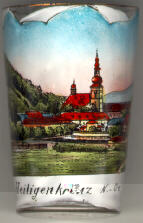

|
| ÖSTERREICH | AUSTRIA |
| Bundesland: Niederösterreich | Lower Austria |
| Bezirk: Baden |
 The
The  Cistercian abbey of Heiligenkreuz was founded
in 1133 by Margrave Leopold III (the Saint) of Austria. It was the first Cistercian
monastery in the duchy of Austria and today is the second-oldest extant Cistercian monastery in the world
after the monastery at Rein in Styria. The first Cistercians came from the
monastery at Morimond in France, where Otto, the fifth son of Leopold, lived
as a monk (he became abbot of Morimond and bishop of Freising in 1138).
The consecration of the first stone church took place in 1187. On this occasion,
Duke Leopold V presented a reliquiary containing a particle of the Holy Cross
to the monastery which became the origin of its name, Heiligenkreuz.
As Leopold V had imprisoned King Richard I of England after his return from the
crusade and asked for a high ransom, he was banned by the pope. After his death 1194 in
Graz he only was allowed to be buried in the monastery
when his sons promised to pay back the money. The last Babenberg Duke of Austria,
Friedrich II, received a reliquiary with a piece of the Crown of Thorns
from King Louis IX of France and presented it to the monastery. Friedrich was
buried 1246 in the chapter house of Heiligenkreuz like twelve other members of the
Babenberg family. Since 1802 Heiligenkreuz is the seat of a Catholic theological school, which in 1976 became a university.
As of 28 January 2007, the feast of St. Thomas Aquinas, Pope Benedict XVI
awarded the university the title 'Papal university' ("Päpstliche Philosophisch-Theologische Hochschule
Benedikt XVI. Heiligenkreuz").
Cistercian abbey of Heiligenkreuz was founded
in 1133 by Margrave Leopold III (the Saint) of Austria. It was the first Cistercian
monastery in the duchy of Austria and today is the second-oldest extant Cistercian monastery in the world
after the monastery at Rein in Styria. The first Cistercians came from the
monastery at Morimond in France, where Otto, the fifth son of Leopold, lived
as a monk (he became abbot of Morimond and bishop of Freising in 1138).
The consecration of the first stone church took place in 1187. On this occasion,
Duke Leopold V presented a reliquiary containing a particle of the Holy Cross
to the monastery which became the origin of its name, Heiligenkreuz.
As Leopold V had imprisoned King Richard I of England after his return from the
crusade and asked for a high ransom, he was banned by the pope. After his death 1194 in
Graz he only was allowed to be buried in the monastery
when his sons promised to pay back the money. The last Babenberg Duke of Austria,
Friedrich II, received a reliquiary with a piece of the Crown of Thorns
from King Louis IX of France and presented it to the monastery. Friedrich was
buried 1246 in the chapter house of Heiligenkreuz like twelve other members of the
Babenberg family. Since 1802 Heiligenkreuz is the seat of a Catholic theological school, which in 1976 became a university.
As of 28 January 2007, the feast of St. Thomas Aquinas, Pope Benedict XVI
awarded the university the title 'Papal university' ("Päpstliche Philosophisch-Theologische Hochschule
Benedikt XVI. Heiligenkreuz").
The Romanesque nave of the  monastery church Mariä Himmelfahrt (Ascension of Our Lady)
was already part of the church consecrated in 1187. The Early Gothic west façade
and the transcept with its Gothic vaulting of the 13th century are the earliest
of their kind in Austria. The spacious Gothic chancel was completed in 1295.
From 1641 onward other parts of the monastery were enlarged in Baroque style.
The church tower also dates from that period. The Baroque interior decoration
of the church was removed and replaced by Neo-Gothic altars in the late 14th century.
monastery church Mariä Himmelfahrt (Ascension of Our Lady)
was already part of the church consecrated in 1187. The Early Gothic west façade
and the transcept with its Gothic vaulting of the 13th century are the earliest
of their kind in Austria. The spacious Gothic chancel was completed in 1295.
From 1641 onward other parts of the monastery were enlarged in Baroque style.
The church tower also dates from that period. The Baroque interior decoration
of the church was removed and replaced by Neo-Gothic altars in the late 14th century.
Other places which claim one of the many reliquiaries of particles of the Holy Crucifix and of which there
are glasses in this collection are the
Cistercian abbey of Lilienfeld (Austria),
the former monastery Heilig Kreuz in Donauwörth (Germany),
the cathedral of Limburg a. d. Lahn and the famous cathedral Notre-Dame
in Paris (France).
|
 Baroness Mary Vetsera, the mistress of Crown-Prince Rudolf, was buried in the
cemetery of Heiligenkreuz after their tragic end in Mayerling in 1889. The most likely
version of their death is that Crown-Prince Rudolf shot Mary before committing suicide himself.
The bones of Mary Vetsera were stolen from the grave in 1991 and re-buried after their
recovery in 1993.
Baroness Mary Vetsera, the mistress of Crown-Prince Rudolf, was buried in the
cemetery of Heiligenkreuz after their tragic end in Mayerling in 1889. The most likely
version of their death is that Crown-Prince Rudolf shot Mary before committing suicide himself.
The bones of Mary Vetsera were stolen from the grave in 1991 and re-buried after their
recovery in 1993.
Glass no. 2623 [left] is labeled "Heilgenkreuz N.-Oe. [Niederösterreich, i.e. Lower Austria] Anna Haasler." Anna Haasler owned a publishing house for picture postcards in Heiligenkreuz in the 1920s.
Another glass in this collection shows a view of the pilgrimage church
Heiligen Kreuz in Villach.
![[scale]](lineal.jpg)